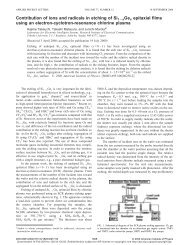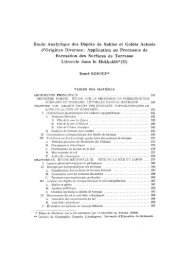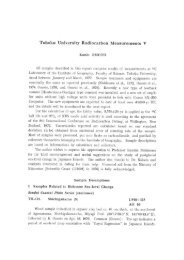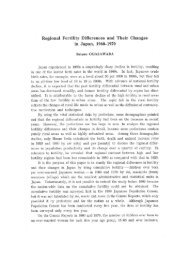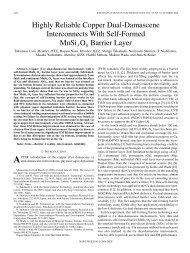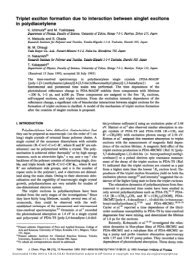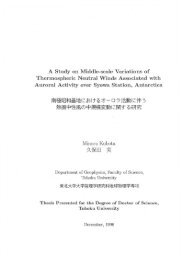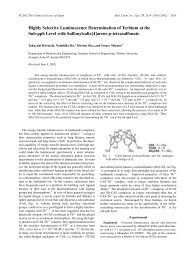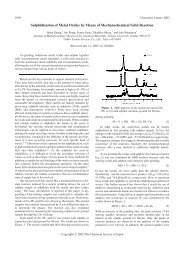Variational Convergence of Finite Networks
Variational Convergence of Finite Networks
Variational Convergence of Finite Networks
Create successful ePaper yourself
Turn your PDF publications into a flip-book with our unique Google optimized e-Paper software.
58 KASUE<br />
L2ð½0; rðeÞŠÞ. Then a canonical energy form EG on D½EGŠ is given by<br />
Z<br />
Z rðeÞ<br />
Let<br />
EGðu; vÞ ¼<br />
G<br />
u 0 v 0 dsG ¼ X<br />
e2E<br />
0<br />
u 0 ðsÞv 0 ðsÞds; u; v 2 D½EGŠ:<br />
juðxÞ uðyÞj2<br />
RGðx; yÞ ¼sup j u 2 D½EGŠ; EGðu; uÞ 6¼ 0 ; x; y 2 G:<br />
EGðu; uÞ<br />
The number RGðx; yÞ is called the effective resistance between the points x and y <strong>of</strong> G.<br />
The form EG has the following properties.<br />
(i) EG is symmetric and positive semi-definite, and EGðu; uÞ ¼0 if and only if u is constant.<br />
(ii) The form EGðu; vÞþuðoÞvðoÞ on D½EGŠ, where o is a fixed point <strong>of</strong> G, is closed in the sense that it provides a<br />
complete inner product on D½EGŠ.<br />
(iii) For a sequence <strong>of</strong> functions un in D½EGŠ whose energies EGðun; unÞ are uniformly bounded, if un uniformly<br />
converges to a function u in CðGÞ as n !1, then we have<br />
EGðu; vÞ ¼ lim<br />
n!1 EGðun; vÞ<br />
for all v 2 D½EGŠ. As a result, the energy form EG is lower semi-continuous on CðGÞ, that is, for a sequence <strong>of</strong> functions<br />
un 2 CðGÞ which uniformly converges to a function u 2 CðGÞ, we have<br />
EGðu; uÞ lim inf<br />
n!1 EGðun; unÞ ð þ1Þ:<br />
(iv) A function u 2 D½EGŠ satisfies<br />
juðxÞ uðyÞj 2<br />
EGðu; uÞd R Gðx; yÞ; x; y 2 G;<br />
and hence by the definition <strong>of</strong> RG, this estimate is restated as follows:<br />
juðxÞ uðyÞj 2<br />
EGðu; uÞ RGðx; yÞ; u 2 D½EGŠ; x; y 2 G;<br />
RGðx; yÞ d R Gðx; yÞ; x; y 2 G:<br />
In particular, we have<br />
juðxÞj EGðu; uÞ 1=2 RGðx; yÞ 1=2 þjuðyÞj; x; y 2 G: ð1Þ<br />
(v) EG satisfies the Markov property, that is, for u 2 D½EGŠ, u :¼ minfmaxf0; ug; 1g 2D½EGŠ and<br />
EGðu; uÞ EGðu; uÞ:<br />
ffiffiffiffiffiffiffiffiffiffiffiffiffiffiffi<br />
(vi) The embedding <strong>of</strong> ðD½EGŠ; EG þ 2 p<br />
oÞ<br />
into CðXÞ is compact, that is, for a sequence <strong>of</strong> functions in D½EGŠ which<br />
are uniformly bounded and whose energies are also uniformly bounded, there exists a subsequence that converges<br />
uniformly to a continuous function.<br />
(vii) The form EG is strong local, i.e., for u; v 2 D½EGŠ, EGðu; vÞ ¼0 if u is constant on the support <strong>of</strong> v.<br />
Now we are given a closed subset K <strong>of</strong> G. For any u 2 CðKÞ, let Au ¼fv2 D½EGŠ jv ¼ u on Kg and also<br />
F K ¼fu 2 CðKÞ jAu 6¼;g. Then in view <strong>of</strong> the properties (iii) and (iv), we see that for any u 2 F K, there exists<br />
uniquely a minimizer HK;u on Au, which is characterized as a function h 2 Au that satisfies EGðh; vÞ ¼0 for all<br />
v 2 D½EGŠ vanishing on K. Define a form EK on CðKÞ by<br />
D½EKŠ¼F K; EKðu; uÞ ¼EGðHK;u; HK;uÞ; u 2 D½EKŠ: Then E K satisfies the same properties <strong>of</strong> (i) through (vi) as EG; however (vii) does not hold true in general. We note that<br />
given a closed subset L <strong>of</strong> K and a function u 2 D½E K Š, E K ðu; vÞ ¼0 for all v 2 D½E K Š with supp v K n L if and only<br />
if EGðHK;u; vÞ ¼0 for all v 2 D½EGŠ with supp v G n L. In addition, let<br />
juðxÞ uðyÞj2<br />
RKðx; yÞ ¼sup j u 2 D½EKŠ; EKðu; uÞ 6¼ 0 ; x; y 2 K:<br />
EKðu; uÞ<br />
Then RK is nothing but the restriction <strong>of</strong> the effective resistance RG <strong>of</strong> G to the set K, i.e.,<br />
R K ðx; yÞ ¼RGðx; yÞ; x; y 2 K:<br />
Now the Markov property (v) implies that the maximum principle holds true for HK;u, that is,<br />
min<br />
K u HK;u max<br />
K u:<br />
Here we recall another important consequence from the Markov property that for u; v 2 D½EKŠ, uv 2 D½EKŠ and we<br />
have






